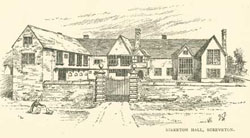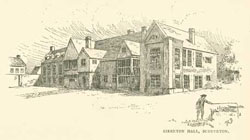Thoroton Hildyard Family Seats
Screveton Hall
Kirketon Hall stood next to the church in Screveton, near the boundary with Car Colston parish. It had medieval and Tudor origins, and was successively owned by the Kirketon, the Leek and the Whalley families. Thomas Thoroton (1636-1695) bought Kirketon Hall and the manor of Screveton from Peniston Whalley (1625-1693), a Nottinghamshire magistrate and owner of virtually the whole of Screveton, in 1685. Re-named Screveton Hall, it became the family's principal seat until a later Thomas Thoroton bought Flintham House in 1789. It was altered by the demolition of a protruding wing, replaced by a more modern set of rooms, early in the 18th century. In his will dated 1793, Thomas Thoroton left the Hall to his wife Roosilia and his younger children. Colonel Thomas Blackborne Hildyard bought it back in 1824, following the death of his grandmother Roosilia Thoroton, and demolished it. In 1827 he gave the land to the church, exchanging it for land owned by the rector of Screveton.


Screveton Hall before and after improvements in the 18th century. Drawings published in Transactions of the Thoroton Society, vol. 1 (1897), between pp 12-17
Flintham Hall
Flintham was owned in the 16th century by the Hussey family, and subsequently by the Hacker and Disney families. Thomas Thoroton bought Flintham House and the Flintham estate from Lewis Disney Ffytche in 1789 for £18,000. His son, Colonel Thomas Thoroton, largely demolished the old house, which had medieval origins, and replaced it with a Georgian three-storeyed house with central bay windows in 1798.
In 1829 a library extension was completed by Colonel Thomas Blackborne Thoroton and his architect, Lewis Wyatt. The entire house was remodelled in Italianate style by his son, Thomas Blackborne Thoroton Hildyard, and the Nottingham architect T.C. Hine between 1853-1857. Hine also added a two-storey glass conservatory. The terrace, gardens, parkland and approach were all altered in the mid-late 19th century. The house has remained in the same form ever since, and was restored by Myles Thoroton Hildyard in the late 20th century.
Pictures of the original house, the 1798 house and the Victorian house all appear in John Cornforth's Country Life article on Flintham Hall, 20 Dec. 1979-3 Jan. 1980 [King’s Meadow Campus East Midlands Collection os.Pamph Not 150.D64 HAL].
Winestead Hall
The Hildyard family came into possession of Winestead in the 15th century. The old medieval hall was pulled down, and a new house built a mile away, in 1597. This Elizabethan house was then rebuilt by Sir Robert Hildyard, 2nd Baronet, in the 1720s. It came into the possession of Colonel Thomas Blackborne Hildyard in 1815, on his marriage with the Hildyard heiress, Anne Catherine Whyte. The house was sometimes known as the Red Hall to distinguish it from another house, the White Hall, built in 1815 by the Maister family on the site of the medieval Winestead Hall, and purchased by Colonel Thomas Blackborne Hildyard in 1829. Family members continued to live in the Red Hall until it was sold by Thomas Blackborne Thoroton Hildyard in the 1880s. It was demolished by Hull Corporation in 1936, at which time many of the fittings and ornaments were rescued and taken to Flintham Hall. An 18th-century stable block designed by John Carr of York still survives.
Next page: Thoroton Hildyard family biographies